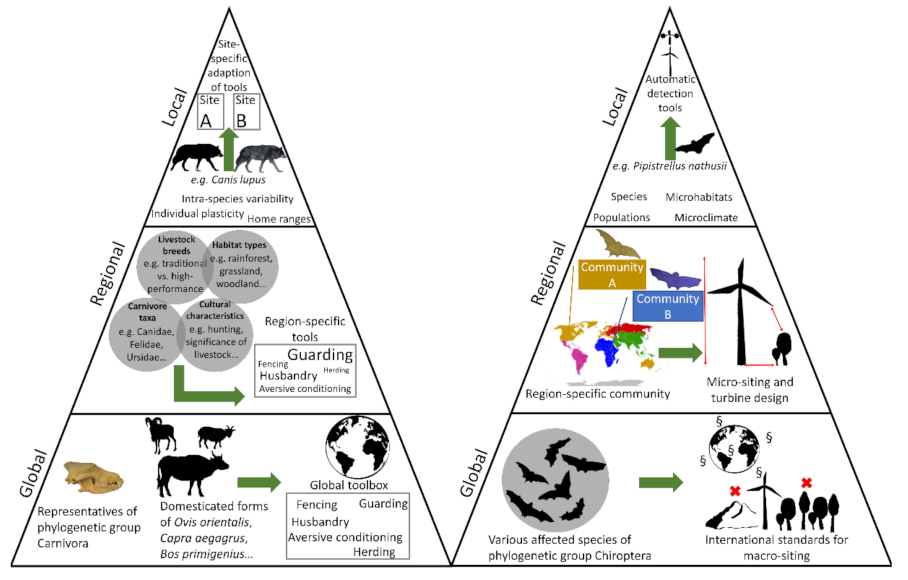In general, human-wildlife conflicts (HWC) are created wherever habitats and the interests of humans and wild animals cross. This worldwide phenomenon therefore affects both humans and wild animals and the causes are numerous and sometimes extremely complex. While some definitions explicitly address the interdependence of the two entities (humans vs. wildlife), others strictly emphasize the negative effects of wildlife on humans, completely disregarding the concept of wildlife. The approaches to this topic are manifold and now include temporal, cultural and political dimensions. The authors of this review article want to approach the topic with their argumentation from the perspective of selected wildlife species and thus promote a more symmetrical view of human-wildlife conflicts.
In the comparison of two contrary examples of human-wildlife conflicts (classic view/human perspective vs. wildlife perspective) the authors assign the mortality of bats caused by wind turbines to human-wildlife conflicts as a form that has so far rarely been taken into account from this point of view. To illustrate the classical view, the authors describe predator-grazing animal conflicts from the point of view of humans, whose livelihood is threatened because elements of artificial biodiversity (domesticated species) are threatened by natural faunal elements (predators). On the basis of these two examples, the authors investigate whether and to what extent human-wildlife conflicts can be minimized or mitigated by supra-regional or even global approaches, or whether case- and region-specific strategies are more necessary. To this end, the authors reflect, among other things, on the legitimacy of ecosystem comparisons across the boundaries of bio- and zoogeographical regions – an important prerequisite for global solutions. In a further step, the authors derive the level of abstraction necessary for a supra-regional approach: the established monophyly of the order Chiroptera (and in the second selected example of the order Carnivora) can help to develop solutions on different spatial (global, regional, local) and systematic (order, family, population, species, individual) scales.
For the mortality of bats caused by wind turbines, the authors synthesize three essential solutions on these scales: 1. Global level: Creation of international standards and binding guidelines for universal site selection to ensure the protection of all bat species occurring worldwide, 2. Regional level: a concept tailored to the region-specific bat community for the concrete design of wind farms (location in space, arrangement, number) and turbine parameters (types, specifications), 3. Local level: a concept tailored to the locally occurring and endangered bat species for the operation of (possibly individual) turbines, including and maximum use of the latest technical methods (artificial intelligence) for the monitoring and application of collision-minimizing algorithms.

Bats are killed by wind turbines in various landscapes around the world. In terms of mortality, wind turbines have even been named as one of the greatest anthropogenic threats to bats worldwide. Thus, hardly any other form of renewable energy is as controversial worldwide as wind energy, which leads to a complicated balancing situation between environmental and nature conservation concerns. Energy demand will increase dramatically over the next 20 years, especially in South America, Asia and Africa, which, in view of climate change, will certainly lead to the construction of thousands of wind turbines on these continents and have a clear impact on the local bat fauna. For example, initial studies on the few systems installed in Africa so far have already documented bat deaths. This fact justifies all the more that the mortality of bats caused by wind turbines will be discussed in the future as a serious human-wildlife conflict, the solution strategy of which must be developed on a global, regional and local level.
Göttert, T., & Starik, N. (2022). Human–Wildlife Conflicts across Landscapes—General Applicability vs. Case Specificity. Diversity, 14(5), 380. https://doi.org/10.3390/d14050380
